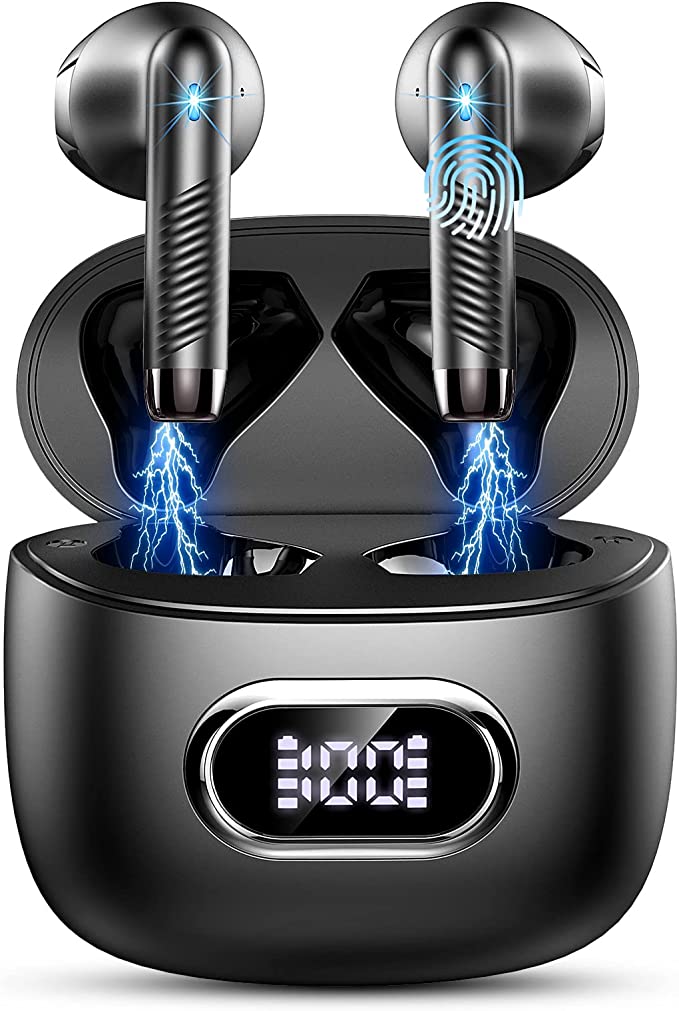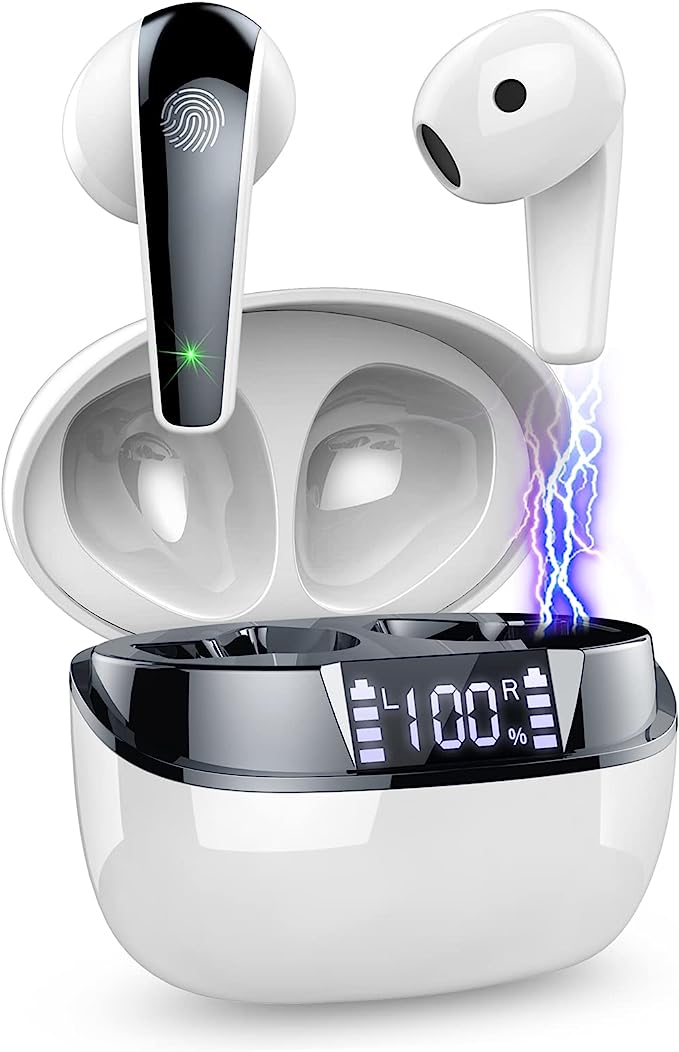Isn’t it remarkable? Just a decade or two ago, enjoying music on the go meant wrestling with tangled wires. Now, tiny wireless earbuds deliver our soundtracks, podcasts, and calls with an ease that feels almost like magic. But behind this seamless convenience lies a fascinating blend of physics, material science, and sophisticated engineering.
While countless brands vie for our attention, the underlying technologies often share common principles. Instead of a review, let’s embark on a different kind of exploration. We’ll use a specific example – the Drsaec J52 Wireless Earbuds, based on their product description – as our specimen. Our goal? To peek under the hood and understand the science that powers the modern wireless audio experience, transforming complex concepts into something we can all appreciate. Join me, Dr. Evelyn Reed, as we decode the tech shaping how we listen.

The Unseen Tether – Weaving Connections with Bluetooth 5.3
The very foundation of any wireless earbud is its connection to your device. The J52 earbuds are described as using Bluetooth 5.3. If you’ve followed tech, you know Bluetooth versions increment over time, but what does “5.3” actually bring to the party?
Think of Bluetooth’s evolution like upgrading our communication highways. Early versions were like single-lane roads, prone to congestion. Later versions added more lanes and traffic management. Bluetooth 5, and specifically its refinements like 5.3, focus on making this highway system more efficient and reliable. According to the Bluetooth Special Interest Group (SIG), the body overseeing the standard, version 5.3 generally emphasizes improvements in connection reliability, power efficiency, and security. While specific performance gains depend heavily on both the sending device (your phone or computer) and the receiving device (the earbuds), the standard itself aims for a smoother ride.
The J52 description mentions using “twin Bluetooth 5.3 technology” for “binaural synchronous transmission,” claiming faster pairing (“increased by 100%”) and a stable connection. While the exact meaning of “twin” technology isn’t specified in the source and the percentage claim lacks context, the intent aligns with Bluetooth 5.3’s goals: ensuring both earbuds receive data efficiently and stay synchronized, reducing frustrating dropouts or lag. It also highlights automatic connection after the initial setup – a small but significant quality-of-life improvement many users now expect.
Crucially, the enhanced power efficiency of Bluetooth 5.3 is a cornerstone of modern earbud design. By sipping less power to maintain that connection, earbuds can either shrink their batteries (making them lighter) or offer longer listening times. This efficiency is a vital thread weaving through the entire earbud ecosystem, directly impacting how long you can stay untethered.

Crafting the Soundwave – The Promise of Graphene Drivers
Connection established, how do these tiny devices actually create sound? The answer lies in the driver – the miniature speaker inside each earbud. The J52 specification highlights a 13mm graphene composite driver. Why graphene?
Graphene is a material scientist’s dream, at least on paper. It’s a sheet of pure carbon, just one atom thick, arranged in a strong hexagonal lattice. Imagine microscopic chicken wire, but incredibly robust for its near-zero weight. These properties – extreme stiffness combined with ultra-low mass – are theoretically ideal for an audio driver diaphragm.
Think of a drum skin. To produce a clear note, it needs to be tensioned just right (stiff) so it vibrates uniformly without wobbling, and it needs to be light enough to respond instantly when struck. Similarly, an earbud driver diaphragm must vibrate precisely according to the incoming electrical signal to recreate sound accurately. Graphene’s stiffness helps it resist unwanted distortion, especially at higher frequencies, while its lightness allows it to move incredibly quickly, potentially leading to crisper transients (the initial attack of a sound) and better detail.
The J52’s description claims its 13mm graphene composite driver delivers a “wider soundstage, detailed trebles and well-defined bass (60%+).” The term “composite” suggests the graphene might be combined with other materials, a common practice to optimize performance or manufacturing. While sonic descriptions and percentages like “60%+” are subjective and lack standardization, the choice of graphene points to an engineering pursuit of high-fidelity sound reproduction, aiming for clarity and responsiveness across the audio spectrum. It’s about leveraging material science at the nanoscale to shape the sound waves that reach your ears.

Clarity in the Chaos – Demystifying 4-Mic ENC for Calls
Wireless earbuds aren’t just for music; they’re essential communication tools. But taking calls in noisy environments can be frustrating. This is where technologies like ENC (Environmental Noise Cancellation), as featured in the J52 with its 4-microphone system, come into play.
It’s crucial to differentiate ENC from the more commonly discussed ANC (Active Noise Cancellation). While ANC primarily aims to cancel out ambient noise for the listener enjoying music, ENC typically focuses on cleaning up the microphone signal for the person on the other end of your call.

How does it work? Imagine you’re in a bustling cafe. The J52’s multiple microphones (likely two per earbud) perform distinct roles. Some are positioned to optimally capture your voice. Others are strategically placed to pick up the surrounding environmental noise – the clatter of cups, chatter, traffic rumble. The earbud’s internal processor then acts like a sophisticated audio editor. It analyzes the ambient noise signal and generates an “anti-noise” signal – essentially, an inverted version of the noise waveform. Based on the principle of destructive interference (where wave crests meet troughs), when this anti-noise is electronically mixed with the microphone signal capturing your voice before it’s transmitted, it helps to cancel out a significant portion of the unwanted background sound.
The J52 description claims its ENC “strongly eliminating external noise which pick up & amplify your vocals even in a crowded space.” The goal is that your voice cuts through the clutter, making conversations clearer for the listener. While effective, it’s worth noting that ENC systems primarily tackle steady-state noise and might be less effective against sudden, sharp sounds. Furthermore, as one user review in the source material mentioned, intensive processing like this during continuous calls can impact battery life – a real-world consideration for any advanced feature.

Resisting the World – IP7 Waterproofing and Everyday Ergonomics
Life happens. Whether it’s an intense workout, a sudden downpour, or just daily wear and tear, earbuds need some resilience. The J52 earbuds and their charging case are described as having an IP7 waterproof rating. Let’s decode that alphanumeric tag.
“IP” stands for Ingress Protection, a standard defined by the International Electrotechnical Commission (IEC 60529). The first digit rates protection against solid particles (like dust). If it’s an ‘X’, as is common for earbuds, it means it hasn’t been specifically tested for dust ingress. The second digit rates protection against liquids. A ‘7’ is quite high on the scale. It signifies that the device is protected against the effects of temporary immersion in water under specific conditions: up to 1 meter (about 3.3 feet) deep for a maximum of 30 minutes.
What does this mean practically? An IP7 rating provides robust protection against sweat, rain, and accidental splashes. You could likely drop them briefly in a puddle or sink and retrieve them without damage (though it’s always best to dry them thoroughly afterwards). It’s important to remember this rating typically applies to freshwater; saltwater or liquids containing soaps or chemicals could still cause harm. For the J52, the claim that both the buds and the case carry this IP7 rating adds an extra layer of reassurance. It’s like having a miniature, well-sealed submarine hatch protecting the delicate electronics inside.
Beyond ruggedness, comfort is paramount for something worn inside your ears. The J52’s description highlights an “ultra lightweight” design at only 3 grams per earbud. While seemingly minuscule, this low weight is critical for long-term comfort and stability, especially during physical activity. Lighter buds are less likely to cause ear fatigue or shift out of place, complementing the secure fit needed when you’re on the move, potentially rain or shine, thanks to that IP7 rating.

The Power Within – Battery Life, Fast Charging, and Staying Informed
All this technology needs energy. The J52 earbuds promise 6-8 hours of listening time on a single charge, with the charging case holding additional power for a total claimed playtime of up to 42 hours. These numbers are influenced by many factors in real-world use – volume level, connection strength, and whether features like intensive call processing are active – but they provide a baseline expectation. The efficiency gains from Bluetooth 5.3 likely play a role here, working alongside the capacity of the small lithium-polymer batteries housed within.
Modern conveniences enhance the power experience. The J52 case features a dual LED display, reportedly showing the charge status of both the case itself and the earbuds nestled inside. This simple visual cue helps avoid the unpleasant surprise of finding your buds dead when you need them. Charging is handled via a contemporary USB Type-C port.
And for those moments when you’re caught short? The description mentions fast charging: placing the earbuds in the case for just 10 minutes supposedly yields up to 1 hour of playback. This rapid top-up capability, often achieved by delivering a higher charging current for a short initial period, is incredibly useful for busy lives, bridging the gap until a full recharge (which takes a claimed 1 hour for the case) is possible.

The Symphony of Science in Your Pocket
Looking back at the Drsaec J52 through the lens of its described technologies, we see not just isolated features, but an interconnected system. The efficiency of Bluetooth 5.3 underpins the battery life needed to power the graphene drivers and the ENC processing. The lightweight design enhances the usability enabled by the IP7 waterproofing. Touch controls provide convenient access to the features managed by the internal electronics.

While this exploration was based on the product’s own description, it reveals the intricate tapestry of scientific principles woven into even affordable, everyday devices. From the quantum world of graphene to the radio waves of Bluetooth, from the acoustic tricks of noise cancellation to the material science of waterproofing, there’s a remarkable amount of ingenuity packed into these tiny companions. The next time you pop in your wireless earbuds, perhaps take a moment to appreciate the invisible symphony of science making that seamless listening experience possible. It’s a testament to how far technology has come, placing sophisticated engineering quite literally within arm’s – or ear’s – reach.




